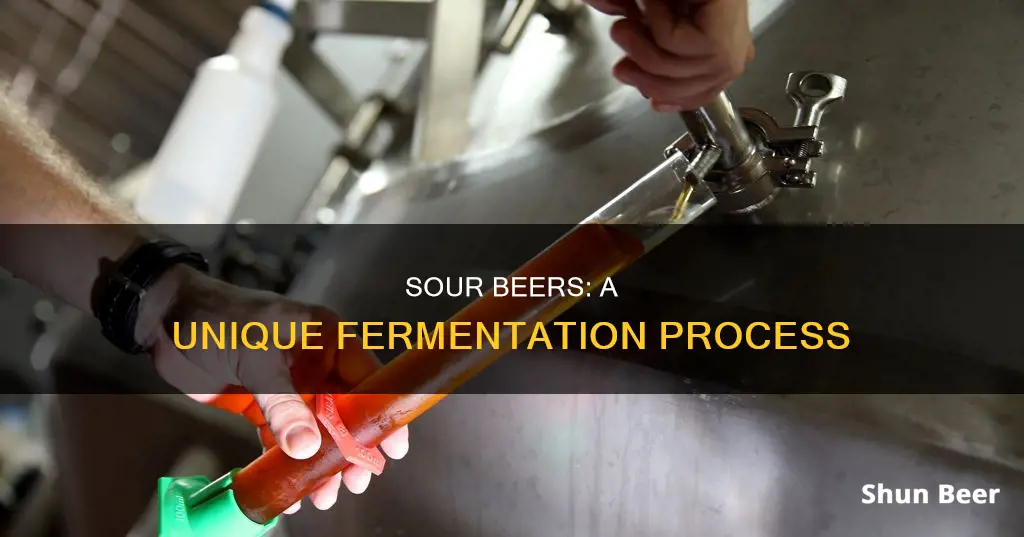
Sour beers are made with wild bacteria and yeast, which create a more acidic taste than regular beers. The process is tricky to perfect – one rogue microbe could infect an already-sterilised beer, causing it to ferment further than intended. The most common bacteria used in sour beers are lactobacillus and pediococcus, which are added after the wort has cooled. The wild yeast used is often brettanomyces. Sour beers are typically aged in wooden vessels, which allow communities of organisms to live in the beer.
What You'll Learn
- Sour beers are made with wild bacteria and yeast, unlike regular beers which use controlled strains of yeast in sterile environments
- Sour beers are often aged in wooden vessels, while regular beers are typically aged in metal tanks
- Sour beers are usually fermented in open vessels, whereas regular beers are fermented in sterile environments
- Sour beers have a longer aging period than regular beers, which can be drunk soon after fermentation
- Sour beers are more difficult to make than regular beers due to the risk of contamination and the tricky fermentation process

Sour beers are made with wild bacteria and yeast, unlike regular beers which use controlled strains of yeast in sterile environments
Sour beers are made with wild bacteria and yeast, which is what gives them their distinctive sour taste. In contrast, regular beers are made with controlled strains of yeast in sterile environments, producing a more familiar flavour.
Sour beers use bacteria like lactobacillus and pediococcus, which create lactic acid and give the beer its signature tart, crisp flavours. These bacteria are also found in dairy products like yogurt, and are responsible for the sour taste in sour milk. The wild yeast used in sour beers is often Brettanomyces, which adds a funky and earthy quality to the beer.
Regular beers, on the other hand, use specific strains of yeast, such as Saccharomyces cerevisiae for ales and Saccharomyces pastorianus for lagers, to produce consistent, familiar flavours. These beers are made in sterile environments to prevent wild bacteria and yeast from infiltrating the brew.
The process of making sour beers is quite different from that of regular beers. Sour beers often require a long aging period, during which the beer is exposed to wild yeast and bacteria to create a unique flavour profile. The fermentation process can be tricky, as one rogue microbe could potentially infect the beer and cause it to ferment further than intended.
Additionally, sour beers are typically aged in wooden vessels, allowing communities of organisms to live in the beer and impart their unique characteristics. The aging process can also affect the flavour of sour beers, making them more complex, funky, and mellow over time.
In contrast, regular beers are usually aged in metal fermentation tanks and do not undergo the same level of exposure to wild bacteria and yeast. The brewing process for regular beers is designed to maintain tight control over the flavours produced, resulting in a consistent product with a familiar taste.
Oktoberfest Beers: What Sets Them Apart?
You may want to see also

Sour beers are often aged in wooden vessels, while regular beers are typically aged in metal tanks
Wooden vessels and metal tanks create different conditions for the beer to age in, resulting in distinct flavours and characteristics.
Sour beers are often aged in wooden vessels, typically oak barrels, which allow the beer to breathe and let microorganisms build communities. This process of aging in wooden vessels is called "aging in oak" or "aging in wood". The wild yeast and bacteria that are allowed to infiltrate the brew during the cooling of the wort in a coolship open to the outside air are responsible for the sour flavour of these beers. The use of wooden vessels allows for a more natural and wild fermentation process, as the beer is exposed to the elements and can interact with the wood of the barrel.
Regular beers, on the other hand, are typically aged in metal fermentation tanks. These tanks provide a more sterile and controlled environment for the beer to age in. By using metal tanks, brewers can maintain tight control over the brewing process and produce more familiar flavours. Metal tanks also prevent wild yeast and bacteria from infiltrating the brew, resulting in a more consistent and predictable outcome.
The choice of aging vessel is an important factor in the brewing process, as it determines the level of exposure to wild microorganisms and the overall flavour profile of the beer. Wooden vessels are often chosen for sour beers to enhance their unique, tart flavour, while metal tanks are preferred for regular beers to achieve a more standardised taste.
Stout vs Porter: Unveiling Beer's Dark Secrets
You may want to see also

Sour beers are usually fermented in open vessels, whereas regular beers are fermented in sterile environments
Sour beers are created through a unique brewing process that involves wild bacteria and yeast, resulting in their distinctively sour taste. This process is a far cry from the controlled strains of yeast used in conventional beer-making, which yields more familiar flavours. The wild organisms in sour beers, including bacteria and yeast, are responsible for their enticing characteristics, offering a range of flavours from intensely sour to light and fruity.
The fermentation process for sour beers typically involves open vessels, such as wooden casks or barrels, which allow the beer to breathe and wild microorganisms to infiltrate the brew. This method is in stark contrast to the sterile environments favoured for regular beers, where specific yeast strains are carefully cultivated to maintain tight control over the brewing process.
The open fermentation of sour beers encourages the growth of wild yeast and bacteria, which can be challenging to manage. Brewers must take precautions to prevent undesirable bacteria from creating off-flavours, such as the vomit-like smell of butyric acid. Additionally, the wild yeasts used in sour beers can cause excessive carbonation, leading to exploding bottles.
The use of wooden vessels for sour beer fermentation is not just a traditional choice but also serves a functional purpose. Wood, particularly oak, facilitates oxygen transport, contributing to the unique flavour profile of sour beers. While oak barrels are commonly used by commercial brewers, plastic buckets with oak chips can be a suitable alternative for homebrewers.
The fermentation process for sour beers often takes a long time, with some sour beers ageing for several months or even years to develop their complex flavours. During this ageing process, the wild yeast and bacteria continue to work, enhancing the sourness and creating a more intricate flavour profile.
In summary, the key difference between the fermentation of sour beers and regular beers lies in the choice of vessels and the level of sterility. Sour beers embrace the wild, fermenting in open vessels that welcome diverse microorganisms, resulting in a range of flavours. On the other hand, regular beers are crafted in sterile environments, meticulously controlling the yeast strains to produce consistent, familiar flavours.
Beer's Reaction to Containers: A Study
You may want to see also

Sour beers have a longer aging period than regular beers, which can be drunk soon after fermentation
The longer aging period for sour beers is due to the use of wild bacteria and yeast in the brewing process, which can take time to develop and interact with the beer. These wild organisms create the distinctive sour, tart, or acidic taste of sour beers. By contrast, regular beers use controlled strains of yeast in a sterile environment to produce more familiar and consistent flavours.
The aging process allows sour beers to develop a wide range of flavours, from intensely sour to light and fruity, or even funky and earthy. The longer the aging period, the more complex and mellow the flavour of the sour beer can become. Aging also increases the acidity of the beer as the bacteria continue to produce lactic acid over time.
Additionally, some sour beers, such as lambics and American wild ales, are exposed to wild yeast during fermentation, making them ideal for aging as they evolve and develop interesting flavours over time. The aging process can also help to smooth out any harsh or undesirable flavours in the beer, creating a more balanced and refined taste profile.
While the longer aging period for sour beers may be seen as a disadvantage by some brewers, it is an essential step in creating the unique and complex flavours that sour beer enthusiasts crave. The aging process allows sour beers to develop layers of flavours that cannot be achieved with regular beers, contributing to their growing popularity among craft beer drinkers.
Beer Carbonation: CO2 Content Varies by Brew
You may want to see also

Sour beers are more difficult to make than regular beers due to the risk of contamination and the tricky fermentation process
Sour beers are made with wild bacteria and yeast, which can make them more difficult to produce than regular beers. The bacteria used in sour beers, such as lactobacillus and pediococcus, can be unpredictable and may take a long time to sour the beer. In addition, the wild yeasts used in sour beers, such as brettanomyces, can be difficult to control and may cause excessive carbonation or off-flavours.
To make a sour beer, brewers must carefully control the fermentation process to maximise desirable characteristics such as lactic acidity and minimise undesirable ones such as acetic acid and buttery flavours. This often involves a longer fermentation process than regular beers, which can increase the risk of contamination and make it more difficult to achieve a consistent product.
The equipment used for sour beers can also be a challenge, as the bacteria and wild yeasts can be difficult to remove completely from brewing equipment. This means that separate equipment is often needed for sour beers to prevent cross-contamination and ensure the desired flavour profile.
Overall, the production of sour beers requires a more careful and controlled approach than regular beers to manage the risks of contamination and unpredictable fermentation. Brewers must be prepared for a longer process and the possibility of failure, but the result is a complex and unique product that is increasingly popular with beer drinkers.
Explore the Diverse World of Beer Styles
You may want to see also
Frequently asked questions
Sour beers are made with wild bacteria and yeast, which give them their distinctive sour taste. Regular beers, on the other hand, are made in sterile environments with specific yeast strains to produce more familiar flavours.
Sour beers typically use bacteria such as lactobacillus and pediococcus, and wild yeast such as brettanomyces.
The brewing process for sour beers involves the fermentation of multiple yeast strains and acid-producing bacteria, resulting in a more acidic taste than regular beers. Additionally, sour beers often undergo a longer aging period and are fermented in wooden vessels, allowing wild organisms to infiltrate the brew.
Some popular types of sour beers include Gose, Berliner Weisse, Lambic, Flanders Red Ale, and American Wild Ale.







